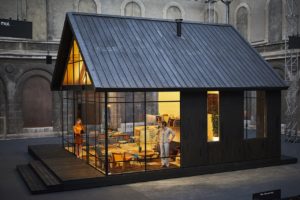Avignon: Ibsen huis – La Maison d’Ibsen, Ibsen reinvented !

Photo. Christian Raynaud de Lage.
Ibsen Huis (La Maison d’Ibsen) Directed by Simon Stone, dramaturgy and translation by Peter van Kraaij, set design by Lizzie clachan, a production by the Toneelgroep Amsterdam
Ibsen Huis is an homage to the genius of Henrik Ibsen, the first European playwright to study the complex intricacies of human psychology and behaviour, conditioned by our follies, indulgences, and failures. However, the play is neither a simple staging of one of Ibsen’s plays, nor is it a modern adaptation. This is a new script and production inspired by Ibsen’s characters in conflict. Created and written by the director Simon Stone and the members of this company hand-picked for this project, Ibsen Huis tells a story of the modern dysfunctional family, through the 50-year span of its history.
The family includes Frederique and Cornelius, the parents of Cees and Thomas, married to Johanna and Birgit respectively. Cees and Johanna are the parents of Lena and Sebastiaan. Thomas and Birgit have three children: Daniel, Vincent and Caroline. Lena, married to Jacob, has a daughter called Fleur. Caroline has her own daughter Pip, and is married to Arthur.
However, the audience needs to know only one thing and we learn that in the course of this four-hour theatrical event: Cees is a monster. An award-warning architect, Cees has stolen his projects from his nephew, Daniel. A child molester, he raped not only his own children, Lena and Sebastiaan, but also his niece Caroline. His grandchildren, Fleur and Pip, are the fruits of Cees’ sexual escapades, eventually they also become his victims.
This gruesome and ugly story reminds us as much of Ibsen’s own theatre as of the Greek tragedies which inspired his theatre as well as Eugene O’Neil’s expressionist theatre which was preceded by Ibsen’s work. At the same time Ibsen Huis feeds on contemporary TV soap-operas that often, in their convoluted narratives , try to raise to the level of tragic intensity .
Director Simon Stone does not hide his artistic aspirations. In its hyper-realistic style, the play is modeled on popular television. The sound-scape was meticulously designed, amplified and mediated, to produce the effect of a digitalized TV programme.
On stage, we see a replica of a beautiful house that Cees built for his family. It is an elegant, two story transparent structure, possibly inspired by European constructivism. The house constantly rotates and with every turn of this massive structure, there is a temporal change in the narrative. There is also a spatial transformation which means that the audience is able to see the action from different perspectives and to learn more about the secrets that keep this family together. Thus, space acquires the power of a metaphor. Although the transparent house is open to the gaze of strangers and passersby, the suffering experienced by every member of this family still remains deeply hidden.
The more horrors we discover about this family, with the ghosts of murdered children and dead family members invading the space, the more surrealist the action becomes and the faster the house disintegrates. What was a pristine, see-through structure in the first act, turns into its own cadaver in the second.
Built in 1964, when the story begins, the house became Lena and Jacob’s grave, when it caught fire in 2004. In the last part of the play, symbolically called The Inferno, the rebuilt house burns again, this time entombing not only the remaining members of this family, but all its ghostly apparitions. The lovers of Ibsen’s canon will be delighted to recognize in this production, traces of Hedda Gabler, Ghosts, The Master Builder, Enemy of the People and The Doll’s House.
What is difficult to reconcile are the grandiose aspirations that went into the making of this show with the somewhat pedestrian dialogue (based on the French subtitles) and the melodramatic action. Nevertheless, the work of the actors and the designers, as often happens in such projects, was simply superb.
In Dutch with French Subtitles. Cast: Claire Bender, Janni Goslinga, Aus Greidanus jr., Maarten Heijmans, Eva Heijnen, Hans Kesting, Bart Klever, Maria Kraakman, Celia Nufaar, David Roos, Bart Slegers
Presented July 15-20, 2017 in the Cour du Lyc/e Saint-Joseph.